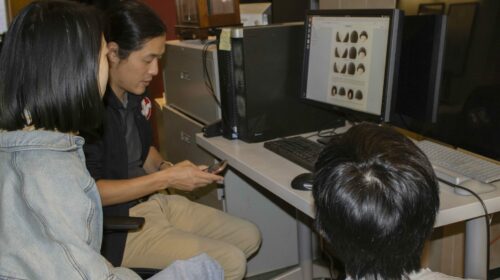Photo Courtesy of Fareed Salmon.
In the past, in computer animation, many Black characters would have poorly animated braids, or more frequently, just have straight hair. For years, computer animations would use these inaccurate representations of tightly coiled hair, also known as afro-textured hair. Recently, as more people of color have been hired and cast for animation roles, the animation industry has moved towards becoming more diverse and inclusive than ever before.
However, this increase in diversity did not translate into more accurate animation of afro-textured hair. “The way that hair has been simulated, at least since the ‘90s, has been many line segments chained together, and making them small enough gives a smooth appearance,” said Theodore Kim, an associate professor of computer science at Yale. Animating hair is achieved through various mathematical equations where the twists of each strand must be carefully simulated for accurate hair motion. “Therefore, when a character shakes their head, you can see realistic movement,” Kim said. However, this process only works for the overwhelming majority of animated characters who are white and have straight hair. “The trouble appears with the physics equations selected for simulation,” he said.
A team of computer scientists at Yale have created a novel physical model that allows for more accurate animation of tightly coiled hair, more realistically capturing the way it looks and moves. “We were concerned with three different types of elastic energy for hair: stretching, bending, and twisting energies,” said Haomiao Wu, one of the lead researchers on the project. “These energies constrain how the strands behave in an elastic way. We proposed a different set of those three energies for a model so that it is more stable.” In other words, they wanted to capture the true essence of afro-textured hair using sophisticated mathematical modeling.
Their isotropic, hyperelastic model was specifically designed for better simulation of tightly coiled hair. “Isotropic means that no matter the direction, the restorative force is the same,” said Alvin Shi, another one of the lead researchers on the study. Restorative force is the force needed for an object to return to its initial size and shape. In this case, it enables a hair strand to return to its initial coiled state, which better captures afro-textured hair. This model is also faster, simpler, and more robust than previous models.
The researchers devised this model by discarding the previous assumption for mathematical equations to simulate the curling pattern of each strand and instead consider large bends and torsions, as well as assuming, to a certain extent, that the hair is non-straight. While this model was designed for kinky, curly, or coily hair, the researchers discovered that it is also effective for straight hair.
As with all simulations, there are flaws. Some of these limitations include the scaling behavior of tight, coily hair and lack of variation in how the hair can look. Currently, the model can account for only two different appearances of afro-textured hair: a clumped look, well-defined curls, and a more picked-out look, or fluffed-out afro-textured hair. By decreasing the radius of a wisp—a clump of hair strands common in afro-textured hair—but keeping the same total number of hair strands, a more picked-out look is obtained. However, these looks are not incredibly realistic compared to real-life individuals with the same hair type. “We are looking to improve on the realistic aspect of our model,” Shi said.
For the next steps, the researchers plan to conduct further experiments with the realism of the simulated hair and possibly test an anisotropic model, meaning the pattern is different in various directions, which could lead to better animations of different hairstyles with afro-textured hair.While no animated content or games are perfect, it is important that Black individuals see themselves adequately represented in the media that they consume. As the creators of one of the first models specifically for tight, coily hair, the team also hopes that other researchers will be inspired to conduct similar research. “We are looking forward to seeing more and more research in this field, not just from us but other researchers as well,” Wu said. Ultimately, they want their model to lead to greater and better racial and ethnic representation in animated games and movies. “It might take longer than we wish for these techniques to be implemented, but we are hoping as soon as possible,” Wu said.

